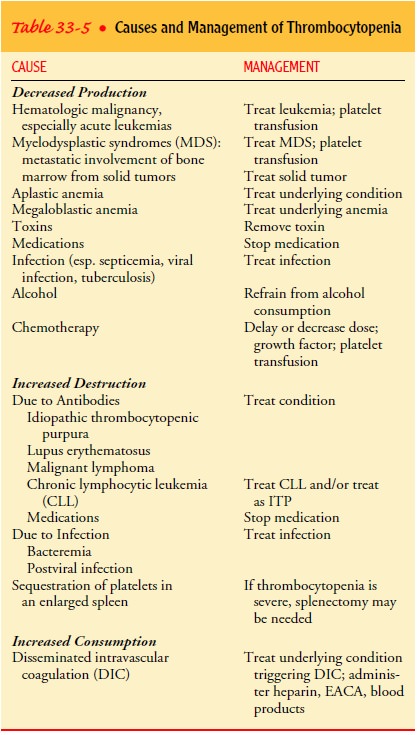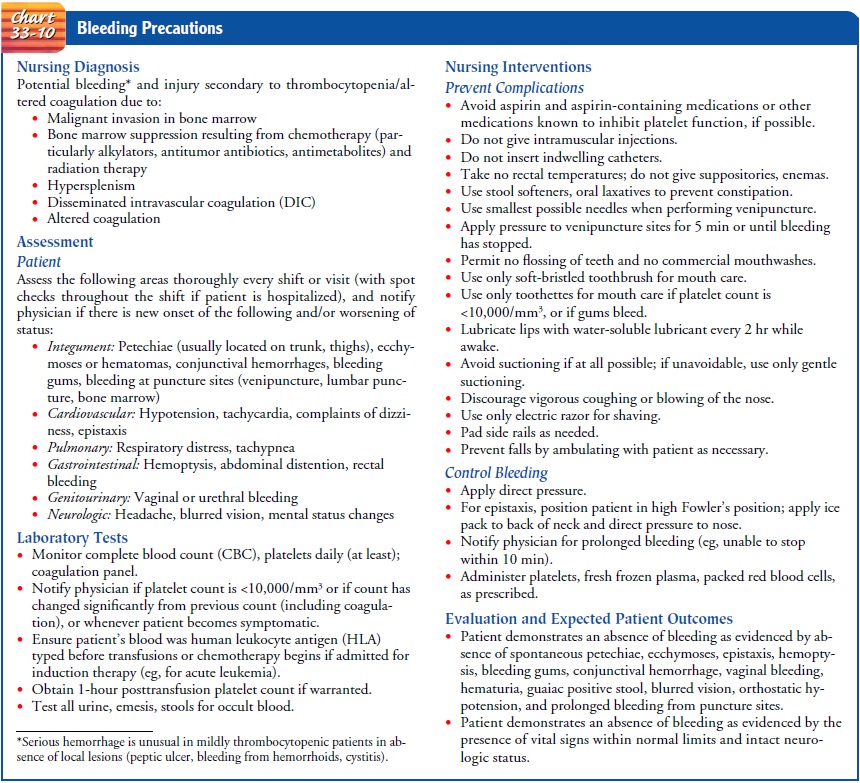Chapter: Medical Surgical Nursing: Assessment and Management of Patients With Hematologic Disorders
Thrombocytopenia
THROMBOCYTOPENIA
Thrombocytopenia (low platelet level) can result from
variousfactors: decreased production of platelets within the bone marrow,
increased destruction of platelets, or increased consumption of platelets.
Causes and treatments are summarized in Table 33-5.

Clinical Manifestations
Bleeding and petechiae usually do not occur with platelet counts greater than 50,000/mm3, although excessive bleeding can follow surgery or other trauma. When the platelet count drops below 20,000/mm3, petechiae can appear, along with nose and gingival bleeding, excessive menstrual bleeding, and excessive bleeding after surgery or dental extractions.
When the platelet count
is less than 5000/mm3, spontaneous, potentially fatal central nervous
system or gastrointestinal hemorrhage can occur. If the platelets are
dys-functional due to disease (eg, MDS) or medications (eg, aspirin), the risk
of bleeding may be much greater even when the actual platelet count is not
significantly reduced.
Assessment and Diagnostic Findings
A
platelet deficiency that results from decreased production (eg, leukemia, MDS)
can usually be diagnosed by examining the bone marrow via aspiration and
biopsy. When platelet destruction is the cause of thrombocytopenia, the marrow
shows increased mega-karyocytes (the cells from which the platelets originate)
and nor-mal or even increased platelet production as the body attempts to
compensate for the decreased platelets in circulation. Another cause of
thrombocytopenia is sequestration. Approximately one third of the circulating
platelets are within the spleen, and a greatly enlarged spleen results in
increased sequestration of platelets.
Medical Management
The
management for secondary thrombocytopenia is usually treatment of the
underlying disease. If platelet production is im-paired, platelet transfusions
may raise the platelet count and stop bleeding or prevent spontaneous
hemorrhage. If excessive platelet destruction occurs, transfused platelets will
also be destroyed, and the platelet count will not rise. The most common cause
of ex-cessive platelet destruction is ITP (see the following discussion). In
some instances splenectomy can be a useful therapeutic inter-vention, but often
it is not a therapeutic option, for example in patients in whom the enlarged
spleen is due to portal hyperten-sion related to excessive alcohol consumption.
Nursing Management
The
interventions for a patient with thrombocytopenia are de-lineated in Chart
33-10.

Related Topics